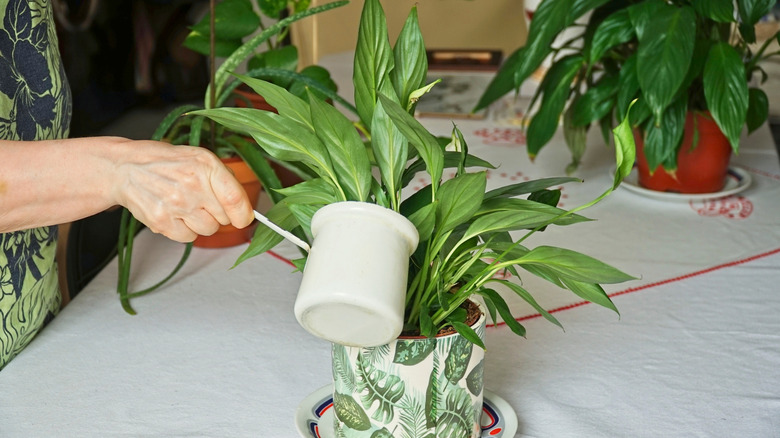Why The Leaves On Your Beginner-Friendly Peace Lily Are Drooping (& How To Fix It)
Plant lovers will know that peace lilies (Spathiphyllum spp.) make gorgeous, beginner-friendly houseplants. Between its glossy leaves, distinctive white flowers, and air-purifying capabilities, this plant would add beauty and freshness to any room in your home. It can be a bit of a drama queen, too, which makes it even more suitable for beginners: When the leaves on your peace lily start to droop, improper watering is usually the culprit.
Wondering how to fix this common issue? The key is to water your plant on the correct schedule and let it drain. How often you should be watering your peace lily varies based on how much light it's receiving. In general, this plant favors indirect light and moist soil. If you're growing your peace lily in a dimly lit room, you can water it once every seven to 12 days. But if it's placed on a tabletop or windowsill where it's exposed to bright afternoon sunshine, you'll need to water it more frequently so its soil retains moisture — think one to two times per week. When in doubt, feel around with a finger. You'll know your plant needs more water when the top layer of soil in its container has dried out. In this scenario, its leaves will perk right back up post-watering.
Other tips for dealing with droopy leaves & keeping your peace lily happy
The tricky thing about peace lilies, particularly for beginners, is that consistently droopy leaves can be a telltale sign of underwatering and overwatering. To solve the mystery, reflect on how often you water your plant — if the frequency exceeds the aforementioned guidelines, then you should let your peace lily dry out a bit more and water it less frequently. This is another instance where a manual finger test can be informative: Overwatering results in soggy, waterlogged soil that needs to air out, while under-watering will leave it feeling dry. Feel it out, and adjust your habits accordingly.
In some cases, drooping leaves can be a sign of root rot. This occurs when your peace lily's roots get slimy and rotten, usually due to prolonged overwatering or poor drainage in its container. To prevent this, be sure to let your plant drain after waterings. But if you catch it too late, and modifying your watering routine doesn't help? At this point, you'll need to cut out the infected roots, clean off the rest of them, and repot your plant in fresh soil. (If you're struggling to spot the rotten roots, take a whiff. They tend to smell pretty bad.)
Another tip for helping your peace lilies flourish indoors is that water quality also affects this plant's health. Peace lilies can get fussy when exposed to some minerals that are commonly found in tap water, such as fluoride. If your plant's leaves look droopy and discolored at the edges, consider switching to distilled or carbon-filtered water, which it can tolerate better.

